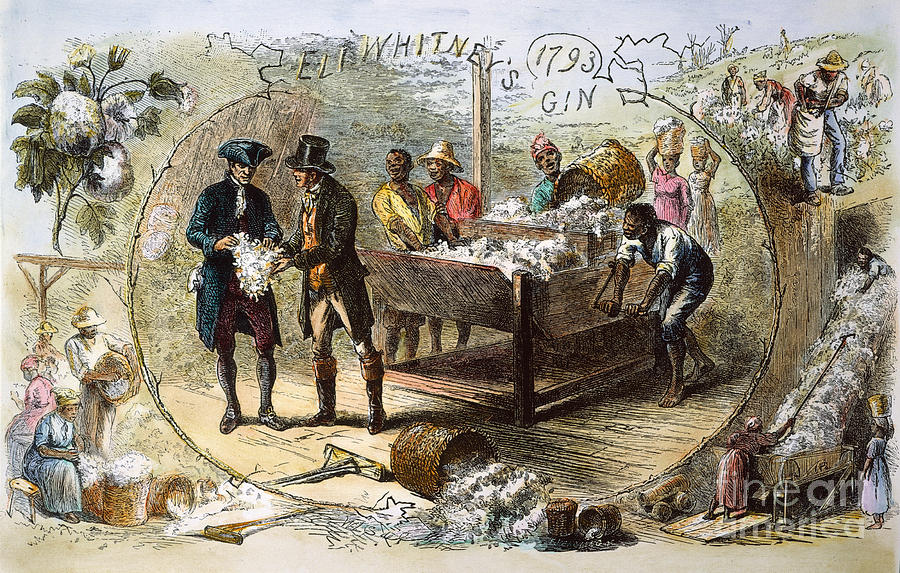
The Cotton Kingdom: A Chronicle of the Old South, by William E. Dodd (1919)
THE region which in the middle of the last century was known as the Cotton Kingdom extended a distance of more than a thousand miles from South Carolina to the neighborhood of San Antonio, Texas. The breadth of this country, from north to south, ranged from two hundred miles in Carolina and Texas to six or seven hundred miles in the Mississippi Valley. The land on which cotton could be easily grown measured perhaps as much as four hundred thousand square miles in 1850, if we count Texas, Arkansas, and Florida, which were then, however, yielding only small crops. Large areas in the lower South were not suited to cotton culture, although they contributed to the cotton kingdom other economic resources of no small value. The pine barrens of South Carolina, Georgia, Alabama, Mississippi, and Louisiana could produce immense quantities of lumber; and the hills and mountains of the two Carolinas, Georgia, and Alabama supplied a large portion of the grain and the whiskey consumed on the plantations.

Map of the Cotton Kingdom, 1860
The cotton belt is a well- watered country with an annual rainfall almost twice as great as that of Illinois or New York. Moreover the snows of the lower Appalachians which lie upon the densely wooded highlands and towering mountains during half the year are carried off through the eastern half of the cotton country by numerous rivers whose average volume is as great as that of the Susquehanna or the Ohio. In addition to these large streams of water there are thousands of smaller rivers, rising among the hills and struggling through the marshes of the low country, which enrich the land and furnish unsurpassed facilities for transportation. In lower South Carolina and Georgia the network of navigable waters brings every parish into touch with Charleston or other coast towns. Farther west the Chattahoochee, the Tombigbee, the Yazoo, the Mississippi itself, the Red, the Sabine, the Trinity, the Brazos, and the Colorado form systems of communication which make it easy to market all sorts of cropsparticularly cotton, which can be hauled profit ably a hundred miles to the river wharves. It is thus a fact of great importance in the study of the lower South that the larger part of the cotton region, somewhat like the tobacco region of colonial times, is within easy reach of Atlantic or Gulf ports.


The soil of the cotton belt, though not so fertile as that of the upper Mississippi valley, was exceedingly productive. In South Carolina and Georgia it had a reddish hue like that of the Virginia up-country; in Alabama and Mississippi it was dark like that of the prairie region of the Middle West; and everywhere it was soft and easily tillable. It produced corn as readily as cotton, but wheat did not thrive on so loose and open a soil. The seasons were so long that two or often three crops of vegetables were raised in a year, with the warm sun and abundant rains as the benevolent allies of the farmer. Peas, potatoes, beans, and fruit could be grown so quickly and abundantly that the problem of subsistence during the Civil War, for example, was much simpler than in any of the European countries fighting in the Great War.

But before the cotton-planters overran the country during the two decades preceding the beginning of this story, this area was virgin country and, with the exception of certain prairie districts, was covered with dense forests, while its river-bottoms were still tangled, impenetrable swamps. And even as late as 1860 the clearing of new lands was a large part of the planter s work. This was done by cutting away the brambles and dense undergrowth and then "deadening" the larger trees by a process of belting or taking away the bark near the ground and thus preventing further growth. This clearing of the forests let the sunlight fall upon the soil and enabled the planter to produce his first crop at a minimum of expense. But the tall, dead trees, from which the winds tore off branches and strewed them over the ground, gave the country side a somber, despoiled appearance, and seemed the skeletons of the monarchs of the forest crying aloud against the desecration of nature and the sheer waste of the finest timber in the world.

The immediate profits of cotton-growing were so much more easily realized than the remote rewards of conservation that the spoliation of timber-lands continued with a ruthlessness unparalleled elsewhere in the world. Men became hardened to this work until the felling of trees became a pastime; and when there was nothing else for slaves to do, they were sent to the "new grounds" to cut timber and burn logs with the idea that older land would soon need to be abandoned and the new be added to the arable fields. West of South Carolina the land was bought at government sales at a dollar and a quarter an acre or was even seized without the formality of a purchase by squatters who entered the public domain, built their cabins, cleared patches of land, and then defied the Federal officials to oust them. The ease with which one might raise a crop of cotton and the relatively large returns which it brought drew men of all classes to the lower South. Thousands of square miles of rich lands within easy distance of navigable rivers gave the people of the region a sense of new opportunity, a feeling that the world belongs to him who can exploit it, and a restless craving for a new life and wide acres all of which influenced profoundly not only the lower South but the whole course of American history. Between 1820 and 1850 almost anything seemed possible to the enterprising man of the cotton country.

No comments:
Post a Comment